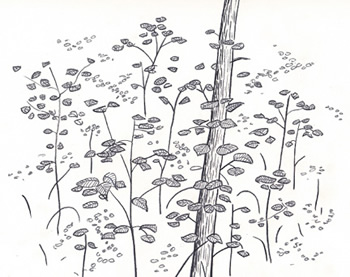| We Knew About the Cave |
| |

|
| |
| 2009 |
| Continuous color 16mm film projection with sound, 12 minutes |
| |
| Request password | View film |
| |
South-central Europe is dotted with caves that were decorated by Homo sapiens 10,000 to 30,000 years ago. In "We Knew About the Cave" a series of static drawings animate the story of Maurice Ravidat, the French teenager who, along with a number of friends, discovered the spectacular painted cave at Lascaux in the Dordogne. Like most examples of Paleolithic art the paintings at Lascaux survived by accident and were found accidentally. It is virtually impossible not to view them as works of art, arranged in a spatial and temporal sequence, within the subterranean architecture of the cave. And doing so we find ourselves wanting to know what they "mean." But the cave is like a bubble, trying to speak without ever saying anything. As one archaeologist puts it "The more you look, the less you understand."*
The teenager’s sensational discovery in September 1940 drew the attention of French luminaries like Pablo Picasso, André Breton, and Georges Bataille before it was quickly closed again and put into service by the French Resistance as a munitions depot during World War II. After the war it was flooded with tourists whose breath changed the climate inside, necessitating Lascaux’s permanent closing.
The drawings in the film do not depict the cave itself, nor the teenage protagonists of the story, but instead show the surrounding forest as it has been imagined from reading descriptions and looking at photographs. The viewer is encouraged implicitly to look for a connection between writing, drawing and speech while the sequence of images passes before them.
*Norbert Aujoulat quoted by Judith Thurman in her essay "First Impressions: What Does the World’s Oldest Art Say About Us?" The New Yorker, June 23, 2008. |
|
| |
| |
| |
| |
| |
| |
| |
| |
| |
| |
| |
| |
| |
| |
| |
| |
| |
| |
| |
| |
| |
| |
| |
| |
| |
| |
| |
| |
| |
| |
| |
| |
| |
| |
| |
| |
| |
| |
| |
| |
| |
| |
|
|
|